Randy Krum's Blog, page 11
September 16, 2019
Social Media Trends of 2019

Gathering together a bunch of the latest research, Awario has summarized the latest data-backed Social Media Trends of 2019
Every aspect of digital marketing requires you to be constantly up-to-date. Social media marketing is not an exception. Actually, scratch that: social media marketing is the very segment where you have to be the definition of trendy.
To know what’s happening in social marketing and what’s about to happen, you need data that answers questions such as “Which tactics are used the most?”, “Which tactics are being planned?”, “Which tools are being developed?”, and so on.
So, we dived in the latest research and created an infographic with the most recent social media marketing data.
Knowing that an infographic image will be shared independently of any text posted along with it, here are a a few things missing from this infographic design that would help:
The source logo! Nowhere on the infographic does it mention that it comes from Awario
The infographic source link. How can readers find the original infographic on Awario’s site?
A copyright or Creative Commons license
What’s going on with this micro-influencer data visualization? That larger circle is WAY MORE than 6.7 times larger!
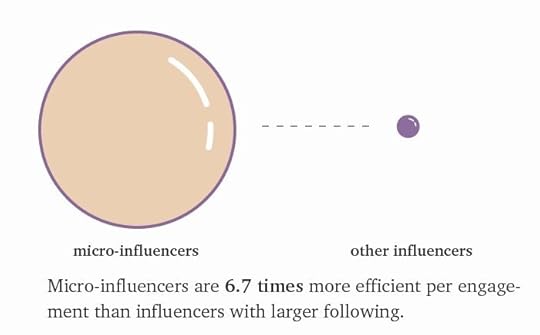

August 16, 2019
NCAA 2018 - Basketball Shot Visualisation
The team at ItoWorld has animated the data from the 2018 NCAA Basketball season into this fun Basketball Shot Visualization video of all of the made baskets and where on the court the shots were taken.
Fun Friday #Sportsviz! My evenings have taken me down another sports-related rabbit hole, this time using basketball shot data from the NCAA.
This visualisation shows all 'scored' points colour coded by the value of the point and visualised over the timespan of a game (many games here!) Data is filtered for just 2018 games, the whole dataset has roughly 4million points from dates back to 2013.
Design-wise the arcs aren't meant to be accurate traces of the shot, just an abstract view of where the point was scored from. Finally, an accumulating hex grid shows the overall pattern of shots taken.
This was a lot of fun to make! All made using out Ito World design tools and the dataset was pulled from here: console.cloud.google.com/marketplace/details/ncaa-bb-public/ncaa-basketball
I appreciate the link to the data source!
Link found by Column Five Media

August 13, 2019
MacBook Setup Essentials for College Students

It’s Back To School time of year, and if you’re a college student with a new MacBook, or a parent setting up a new MacBook, the MacBook Setup Essentials for College Students infographic is for you. These are my personal Best Practice suggestions for setting up a MacBook for college students. (and I’d love to hear your tips in the comments)
MacBook are very popular with college students, but a little planning and configuration is required for the best experience. A student moving away to college might be the first time they have full control over their own computing experience: installing apps, protecting their privacy, creating good passwords, avoiding viruses & malware, and backing up their data.
These are my suggestions for setting up a MacBook, MacBook Air or MacBook Pro for any college student to simplify their computing experience.
I tend to be the Apple tech support for my family and friends, and this year I’m sending my own son away to college. Whether you are new to Apple computers, or an experienced Apple power user, these tips will help you with the initial MacBook setup for any college student going away.
NOTE: Most of these tips are good for any MacBook user, but I’ve tailored them specific to college students.
Unlike many of my other infographic designs, this one doesn’t have any numeric data to work with. It’s a How-To informative infographic with step-by-step instructions and suggestions. That makes it a little more text-heavy than I normally like, but in this case I felt it was appropriate.

July 19, 2019
Neil & Buzz Go For A Walk

Neil & Buzz Go For A Walk is an interactive, scrolling Data Adventure, designed by RJ Andrews, data storyteller and author of Info We Trust. It documents their activities and visualizes the radio transmissions during their 2+ hour space walk in 1969. A great project in honor to the 50th anniversary of the space walk!
It is best on a big screen like a tablet or monitor (show up with a tiny screen: get a tiny experience).
NEIL AND BUZZ was motivated by a realization: I had no idea what happened on the Apollo 11 moonwalk beyond Neil’s ONE SMALL STEP and that iconic flag photo. How many moonwalks were there? Just one. How long were they out there? About two hours. How far did they explore? An area about as big as a baseball diamond. What exactly did they do?
To answer these questions I dove into a wealth of NASA resources. Almost immediately I was struck with a the vision of a scrolly tour through moonwalk highlights. While superficially hand illustrated, the project's chief planning documents include a 3D model, layered map, and detailed timeline of the Moonwalk. Read the design essay to learn more about the making of this data story. -RJ Andrews
The conversation bubble visualization under the illustration took me a minute to understand.
Each column is a two-minute block of time, and each bubble represents the length of time someone was broadcasting a radio transmission. Above, only the major portion of the radio conversation is visualized in the style of modern text message bubbles above, and those are color-coded to the speaker.
Color distinguishes Neil and Buzz’s action and dialog. Commander Neil Armstrong received red as homage to the red commander stripes worn on future Apollo missions. Buzz patriotically balances with blue. Mike Collins, orbiting above, got yellow gold for his cameo, filling out the primary palette.

The bubbles below are color-coded to match the text bubbles above. Any radio transmissions that were skipped remain in gray, but when you reach the end, all of the bubbles are fully colored to complete the visualization.

Check out RJ’s complete Design Essay on what it took to develop this design, and you can follow RJ on Twitter @infowetrust

July 1, 2019
Sales vs. Marketing

The marketing team for Salesforce Pardot has been doing a great job of playing off the Game of Thrones theme with a number of different content pieces. Fight for the Throne: Sales vs. Marketing is a fun, engaging infographic that plays to fans of the HBO series now that the series os over.
Let’s face it: you don’t need to be watching HBO’s acclaimed series Game of Thrones to see a rivalry like the Starks and Lannisters. A similar struggle for power and recognition is happening in the modern office everyday — between sales and marketing.
With different goals, motivations, and tools, aligning your company’s sales and marketing departments can be a daily challenge. With each team staking their claim to different areas of the business process, it can be hard to find any common ground with which to bring them together. However, when sales and marketing work together to generate leads, nurture relationships, and close deals, a company can thrive. There’s a lot at stake in this struggle!
To help you identify the pain points, mindsets, and opportunities for peace between these two departments, we have put together the fun and informative infographic below.
Sometimes the messages you want to convey in an infographic aren’t based on numeric data, but concepts and business processes. This design does a good job of identifying different corporate departments as rival houses with competing interests.
I also like that the ideas presented here have a long Online Lifespan. This infographic is actually an update to an earlier one they released in 2013: Sales vs. Marketing: The Original Game of Thrones. The rivalry between Sales and Marketing isn’t new in corporate culture, and won’t be going away anytime soon.
Found on the American Marketing Association blog

June 25, 2019
Visualizing Apple Product Release Patterns (2019 Update)
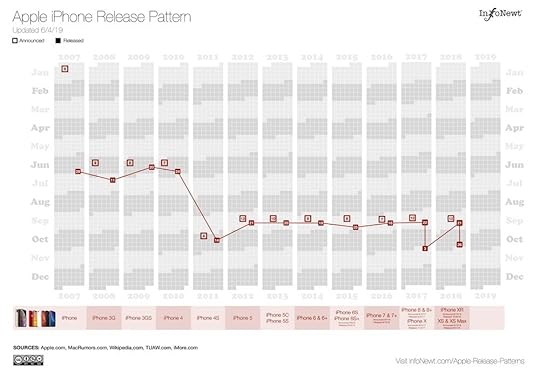
After Apple’s WWDC (Worldwide Developer’s Conference) Keynote presentation in June 2019, I updated my series of infographics, Visualizing Apple Product Release Patterns to catch up on all of the latest releases in 2019. You can see them all on the InfoNewt site, and that’s where I continue to maintain them and post updates as Apple releases new products and updates.
This year I further broke apart all of the individual product lines so you can see their separate release patterns, or lack of any discernible pattern. Some product lines, like the iPhone Release Pattern (ABOVE), have clearly defined release patterns that can be used to predict future product announcement and releases. In this smaller graphic (BELOW), I only show the iPhone release dates in September every year since 2012 to predict the 2019 iPhone announcement and release dates based on their history:
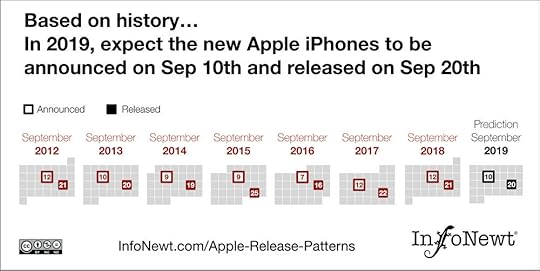
Apple iPad
The Apple iPad Release Pattern doesn’t follow the same timing as the iPhone. The iPad has its own lifecycle and separate release events. It hasn’t been included in the major September iPhone events for the last few years, and has been consistently receiving updates in March for the last four years.

MacBook Pro
Other product lines, like the MacBook Pro Release Pattern, show no obvious pattern. Apple doesn’t release new MacBook Pro updates on a regular schedule. Instead, it’s based on the release of new processors from Intel and the timing of when other new technology is available, like the new keyboard designs and the Touch Bar.

Apple Watch
The Apple Watch follows the iPhone pattern of September announcements:
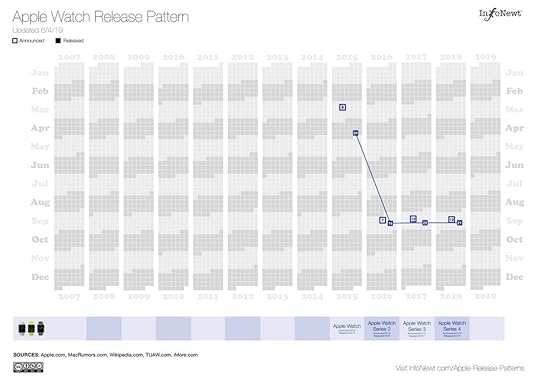
Apple TV
Apple TV updates have been fairly scattered throughout the year, but the last two have been in September with the iPhone announcements:

MacBook Air
The MacBook Air Release Pattern seems to be one of opportunity. A combination of when updates are ready and included in one of Apple’s other larger events throughout the year.

Apple iMac
The iMac Release Pattern shows a two-year gap between the last couple of updates
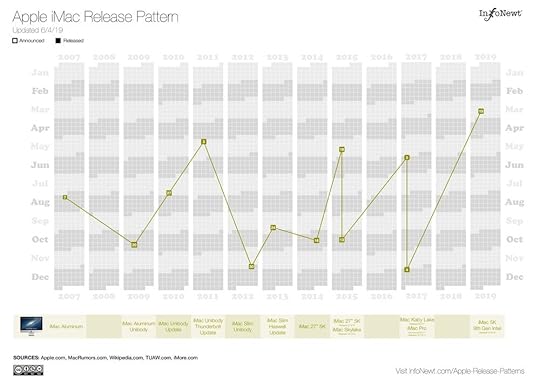
Apple Mac Pro
The Apple Mac Pro Release Pattern shows the huge, multi-year gaps between updates. The last three Mac Pro announcements have all happened during WWDC Keynote presentations.
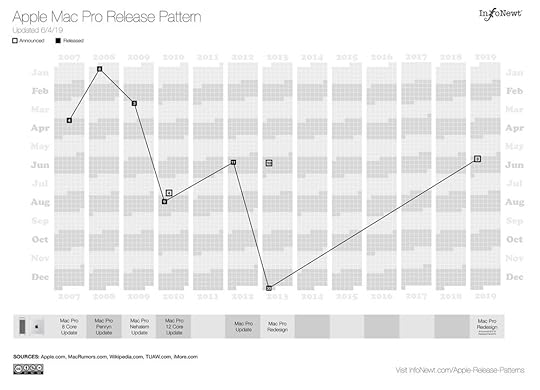
Apple Mac Mini
The Apple Mac Mini Release Pattern also shows multi-year gaps between updates.
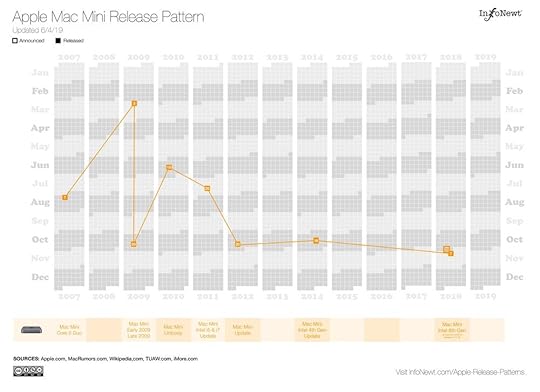
Apple Total Combined Release Patterns
It looks fairly chaotic in total, but the Apple Combined Released Patterns shows all of the product lines together in one timeline. Although the individual patterns are hard to identify, in aggregate you can see that Apple generally avoids any product launches during Jan-Feb and Nov-Dec.
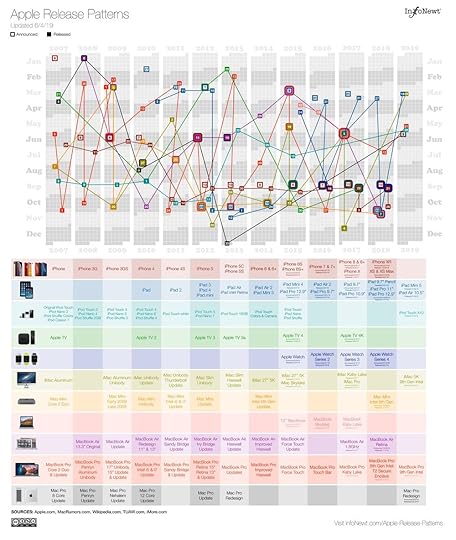
I designed the original Apple Release Patterns in 2013, and have continued to update them ever since as Apple releases new products and updates. I like this visual layout of each calendar year as a column with the days of each month correctly organized so you can discern the days of the week.

June 7, 2019
The Periodic Table of the Elements in Danger
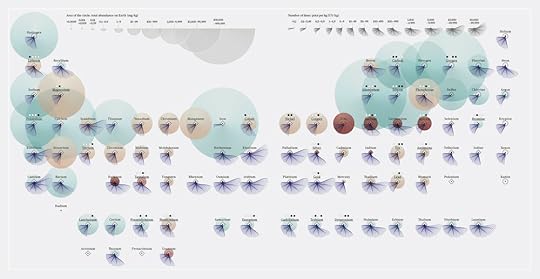
The Periodic Table of the Elements in Danger was designed by Federica Fragapane for the BBC Science Focus.
The piece is a visual exploration of the periodic table and the under threat elements.
The substances depicted have been used to make everything from rocket fuel to raincoats, but our over-reliance on some – especially those used in smartphones – is starting to put a strain on resources. (BBC Science Focus).
For each element the following data have been visualized: total abundance on Earth, scarcity, price per kg, state at room temperature and part of the smartphone the element is used in.
This was originally designed for print publication in the BBC Science Focus, that’s why the graphic image doesn’t have it own title, sources, and the legend is a separate graphic. Federica posted a number of details on her Behance page, and I wish she had put the pieces altogether into one comprehensive infographic meant for online sharing on her own portfolio.
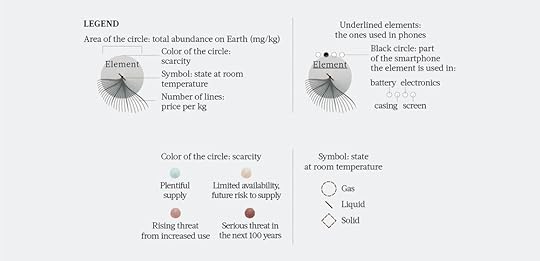

June 4, 2019
The 2019 Summer Reading List

This year I’ve decided that I have a Summer Reading List, and I invite you to join me. I have a library of over 100 books on data visualization, infographics and visual communication but I don’t always take the time to carefully read and understand them. I often have books that are sent to me or I’ve purchased, and they pile up. I start off with the good intentions of reading them, but the pile continues to get bigger.
I fully appreciate how much work goes into writing these books. I wrote the Cool Infographics book, and I was the Technical Editor for Building Responsive Data Visualization for the Web, by Bill Hinderman. Developing valuable content, crafting clearly understandable explanations, finding or designing good examples, editing for clarity and accuracy, designing a functional, useable book layout and finally all of the printing, publishing, marketing and compatible web content.
I know there are some incredible insights in these books. Things these authors needed to get out of their system and clearly explain within the pages. I want to learn from them!
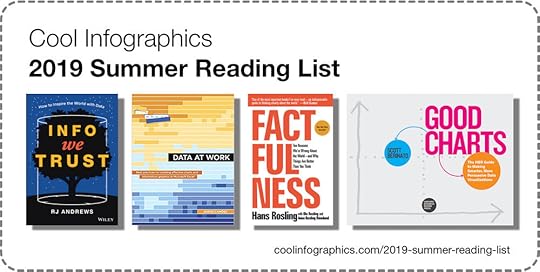
I’ve chosen one book per month for June - September, and for each book I want to accomplish the following things:
A book GIVEAWAY of the selected book the first week of each month
At the end of the month, I will post my thoughts and I would like to hear your thoughts and questions from the book in the comments
I will try to get an interview with each author, and ask them some questions submitted from you. (I know Hans Rosling has passed away, but I may be able to get in touch with one of his children that are continuing to run his organization.)
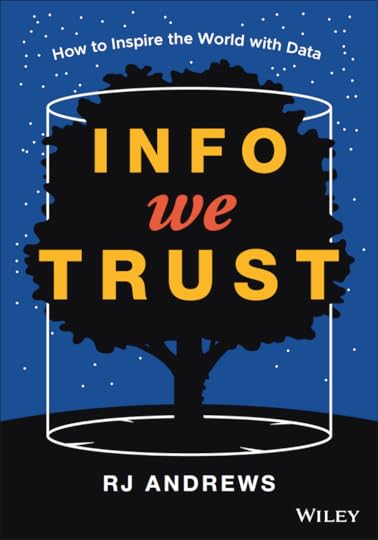
June: Info We Trust by RJ Andrews
How to Inspire the World with Data
How do we create new ways of looking at the world? Join award-winning data storyteller RJ Andrews as he pushes beyond the usual how-to, and takes you on an adventure into the rich art of informing. Creating Info We Trust is a craft that puts the world into forms that are strong and true.

July: Data At Work by Jorge Camões
Best practices for creating effective charts and information graphics in Microsoft Excel
Information visualization is a language. Like any language, it can be used for multiple purposes. A poem, a novel, and an essay all share the same language, but each one has its own set of rules. The same is true with information visualization: a product manager, statistician, and graphic designer each approach visualization from different perspectives.

August: Factfulness by Hans Rosilng
Ten Reasons We're Wrong About the World--and Why Things Are Better Than You Think
When asked simple questions about global trends―what percentage of the world’s population live in poverty; why the world’s population is increasing; how many girls finish school―we systematically get the answers wrong. So wrong that a chimpanzee choosing answers at random will consistently outguess teachers, journalists, Nobel laureates, and investment bankers.
Our problem is that we don’t know what we don’t know, and even our guesses are informed by unconscious and predictable biases.
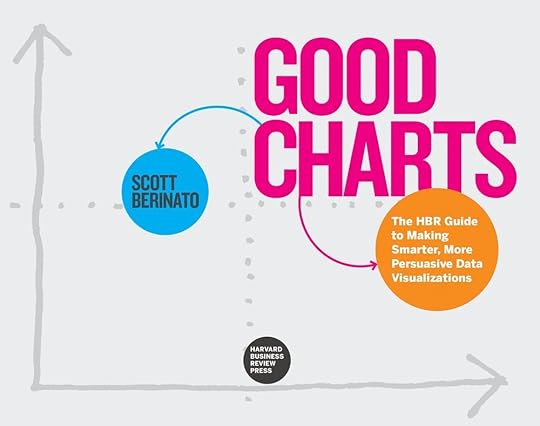
September: Good Charts by Scott Berinato
The HBR Guide to Making Smarter, More Persuasive Data Visualizations
A good visualization can communicate the nature and potential impact of information and ideas more powerfully than any other form of communication. In Good Charts, dataviz maven Scott Berinato provides an essential guide to how visualization works and how to use this new language to impress and persuade.
BOOK GIVEAWAY!This is short notice for June, but I am giving away a copy of Info We Trust on June 10th! You can enter for a chance to win a free copy of the book here: coolinfographics.com/giveaway
Enter by Midnight on June 9th, and I will draw a random winner on Monday, June 10th!ENTER the June 10th Giveaway for "Info we trust"

May 20, 2019
Visualizing how Fans Rated the Last Season of Game of Thrones

Fans have not reacted well to the final season of Game of Thrones, and The New York Times has visualized the fans disappointment by charting the average user ratings on IMDb for every episode of the eight-year run. You can see above How Fans Rated the Last Episode of Game of Thrones as the worst episode of the entire series.
The data is questionable, since the ratings are mostly upset fans taking to IMDB to share their dislike. Fans never like to see their favorite shows come to an end, but the NY Times also reached into the data for other long running TV series to see how their final seasons fared.
Here are a few other popular shows they found that also dropped significantly in their final seasons:
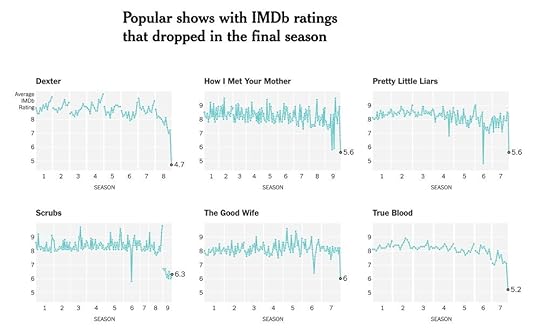
However, they were also able to find other popular shows with fan ratings at their highest during the final season or even the series finale:

These well-designed line charts do a great job of quickly showing the reader the over all trend, and any outliers (high or low).
My only hesitation with the choices they made when designing these charts is the y-axis. I appreciate that they kept the scale consistent throughout all of the charts in the article, but the non-zero baseline starting at 4.5 is an odd choice. Non-zero baselines are generally a poor design practice, and can mislead viewers that aren’t paying close attention. It looks like using a non-zero baseline was chosen to maximize the visible differences between the ratings, but on a 0-10 scale, it wouldn’t have been much different with a true zero-baseline.
Also, the decision specifically for 4.5 appears to be driven by the show Dexter, which has the lowest rated episode at 4.7. The choice of 4.5 as the baseline allows all of the data to be viewable within the scale.

May 6, 2019
Visualizing 40 Years of Music Industry Sales
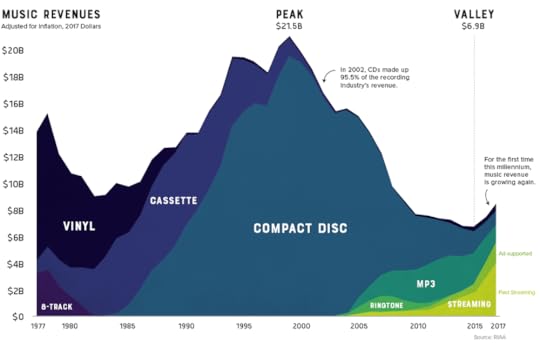
Visualizing 40 Years of Music Industry Sales from Visual Capitalist is a great data visualization design that clearly shows the evolution of music sales. Compact discs clearly set a unmatched precedent.
The record industry has seen a lot of change over the years.
8-tracks took a short-lived run at the dominance of vinyl, cassettes faded away as compact discs took the world by storm, and through it all, the music industry saw its revenue continue to climb. That is, until it was digitally disrupted.
Looking back at four decades of U.S. music industry sales data is a fascinating exercise as it charts not only the rise and fall the record company profits, but seismic shifts in technology and consumer behavior as well.
I also like this even clearer view that only distinguishes between Physical vs. Digital:

These designs hit many of the best practices:
Clean chart design.
A few important highlights as callouts.
Minimal text.
The data is labeled in the chart which eliminates the need for a separate chart legend.




